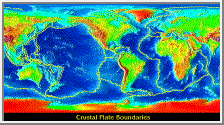
Subduction
By Tom Scott
What is Subduction
Introduction
The coldest parts of the earth's mantle are near the surface, where two tectonic plates move and meet under the influence of convective cells within the mantle rocks.Areas of plate convergence can be mappped
At the point of convergence one plate Subducts the other pushing down at an angle into the mantle. There are 2 types of subdution margin. The first is where two Oceanic plates meet the other is where an Oceanic and a Continental plate meet, with the Oceanic plate always being the one subducted.

A diagram showing the two types of subduction zone.....
This 'subduction' takes the cool plate, up to a few kilometers deep down into the mantle, cooling the general area of subduction. The diagram below shows a theoretical isothermal cross-section of such a zone.
Volcanic arcs and Subduction
At a spreading centre, Oceanic crust is formed from upwelling basaltic magmas. Upon mixing with sea water circulated through cracks in the oceanic crust the basalts are hydrothermally metamorphed, changing their chemistry from an anhydrous mafic mineral assemblage to a rather more hydrous assemblage. Therefore a typical ocean ridge basalt would contain about 1.0 % by weight of water, held in minerals such as biotite mica and amphibole.
As an oceanic plate subducts under another plate, to a depth of 25 km the basaltic crust containing quartz, plagioclase, mica and amphibole is unchanged.
Although the temperature of the subducting plate is relatively cool, by a subduction depth of 75 km the plate is subjected to extreme pressure and higher temperatures. This new P-T environment causes 'Blue Schist' metamorphism, which causes constituent minerals to form into others such as blue sodium rich amphibole ( Glaucophane.) chlorite, Calcium-ALuminium Silicates and small amounts of Garnet.
Past 75 km depth the increasing pressure and temperature metamorphs the hydrous minerals into Anhydrous pyroxenes (50%), Garnet (30%), and other mafic minerals. This last reaction causes the release of 60% of the water held in the rock, as hydrous minerals change to form anhydrous. The water released rises up into the mantle wedge above the subducting slab and Fluxes the 'Peridotite' mantle rocks.
This fluxing depresses the solidus temperature of the peridotite by some 400 degrees, causing it to melt and rise to the surface as a less dense body of water rich magma. These bodies reach the surface forming vulcanic landforms, from Granite intrusions to Volcanic arcs.
Summary
The action of subduction produces a deep oceanic trench backed by an accreted sedimentary forearc at the point of subduction,
while volcanic arcs are spawned by the upwellings of magma generated by water 'Fluxing' of the mantle wedge above it,
at a 100km depth.
That is basically subduction and the landfroms you can find at the margins where it occurs.
Back up?
here are some links that go to sites of interest which are relevant to me!!!
I work for a computer game team, the game I am working on is called
Blasted Wastes.If you are looking for some good clipart go
here. If you want to find an illustrated geology
library?
Last Updated: 28 April 1997
© 1997


Useful links
A Little Devil Production


